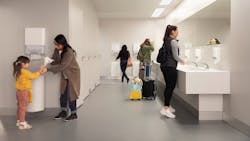The Hidden Power of Restroom Dispensers: What Every Facility Leader Should Know
Facility leaders may be surprised to learn that restroom issues comprise 45% of all office building complaints, more than any other reason.[1] A major element of avoiding complaints in the restroom is keeping them well stocked—and ensuring you have the right dispensers to serve guests and employees.
While restroom dispensers might blend into the background, they are critical lifelines of any facility. These essential fixtures are the backbone of proper hygiene, ensuring that restroom users can maintain proper hygiene and have positive experiences. Read on to learn four facts about the restroom dispenser that will change the way you view this vital component of your facility.
#1: Not All Restroom Dispensers Are Created Equally
Contrary to the perception that all restroom dispensers function similarly, there are thoughtfully designed features that allow some dispensers to be more usable for more people. For instance, the pull force required to dispense paper towels or toilet paper can vary. In the U.S., dispensers must meet the ADA requirements concerning pull force, which is not necessarily mandated in other regions. This consideration is especially crucial for accommodating individuals with varying hand strength, such as children or those with arthritis.
Moreover, issues with dispensers are common: around one in five Americans experience difficulties using soap or hand towel dispensers due to an injury, health condition, physical capability or as a parent with a child.[2] Keeping these considerations in mind can help you select dispensers that enhance user satisfaction for most people.
#2: Better Packaging = Faster Refills and Happier Staff
Dispenser refills are delivered to facilities in cardboard boxes, but not all packaging is created equal. To help your cleaning team perform refills more easily and ergonomically, consider products that come with ergonomic packaging features, such as perforated handles to make carrying easier.
This small adjustment can facilitate a smoother refilling process, allowing your staff to manage their tasks more efficiently—which is critical as the industry faces high turnover and staffing shortages.
#3: Product Choices Impact Sustainability
The quest for sustainability in facility management raises an important question: is it more beneficial to eliminate cardboard rolls by opting for coreless products, or should facilities focus on purchasing products made from recycled materials? There are benefits to both approaches, and it’s important to consider a product’s full life cycle, including carbon impact from production, packaging and transit, when selecting your facility’s products.
Research shows that 67% of guests would like public restroom managers to be more considerate about sustainability and the environment when it comes to restroom solutions or management.[3] So, regardless of the products you select, what really matters is showing guests and employees that sustainability is a top priority.
#4: Restroom Dispensers Can Be Smart Too
As facilities embrace smart technologies—from security systems to energy-efficient lighting—restroom dispensers are also evolving. Many large facilities, including office buildings, sports arenas, and passenger terminals, are beginning to incorporate data-driven technology that optimizes cleaning workflows through connected dispensers.
These connected soap, paper towel and toilet paper dispensers notify cleaning staff when supplies are low, allowing for timely refills and reducing the likelihood of runouts. By enabling cleaning teams to focus their efforts on areas that require the most attention, you enhance overall restroom hygiene and maintenance efficiency.
Bottom line, the next time you enter a facility restroom, you may look at dispensers differently. They’re more than just functional installations—rather, they’re critical components that affect user experience, operational efficiency, and environmental sustainability. By considering these five insights, facility managers can make informed decisions on the types of dispensers they implement and how they manage restroom supplies, ultimately enhancing guest satisfaction and supporting broader business goals.
About the Author
Katrin Ferge
Katrin “Kat” Ferge is the North American Regional Marketing Manager for Professional Hygiene – Commercial segment at Essity. In her role, she is focused on Essity’s professional hygiene brand Tork and helping businesses including office buildings, recreational facilities, passenger terminals and educational institutions leverage better hygiene for better business performance. She has more than 15 years of experience in brand communications and marketing. Kat received her bachelor’s degree from Ludwigshafen University of Business and Society in Germany and later received her MBA from the Thunderbird School of Global Management at Arizona State University.
